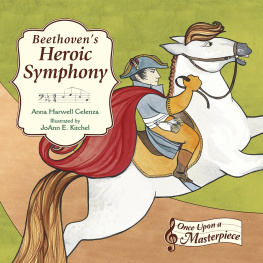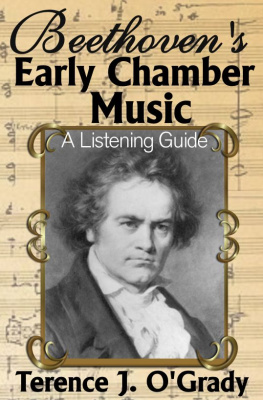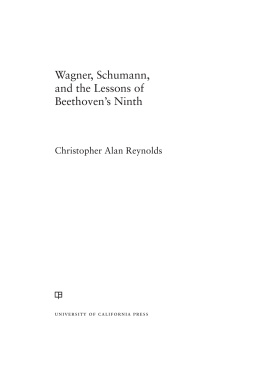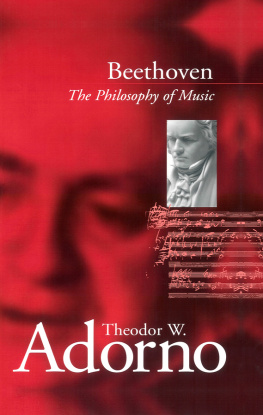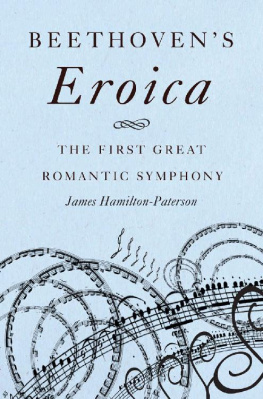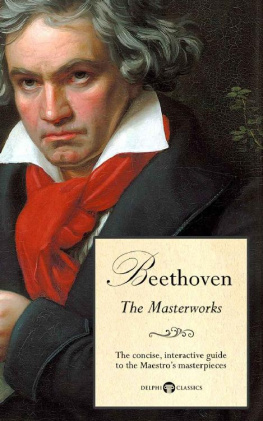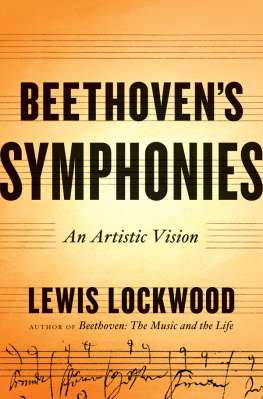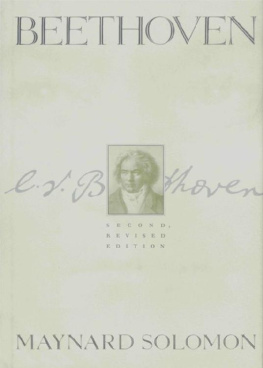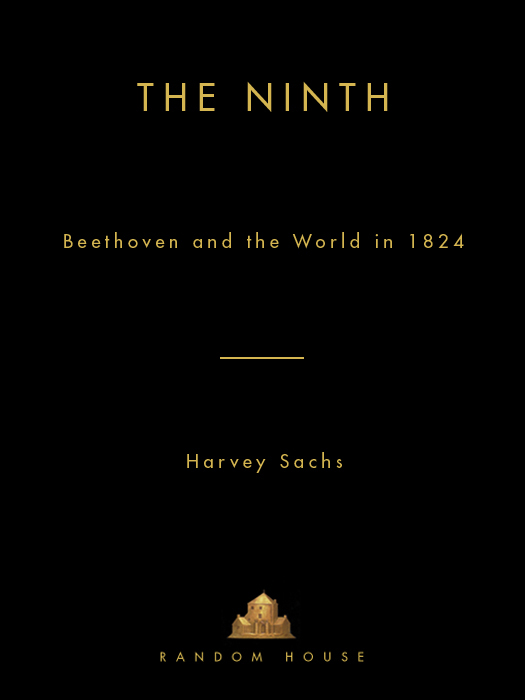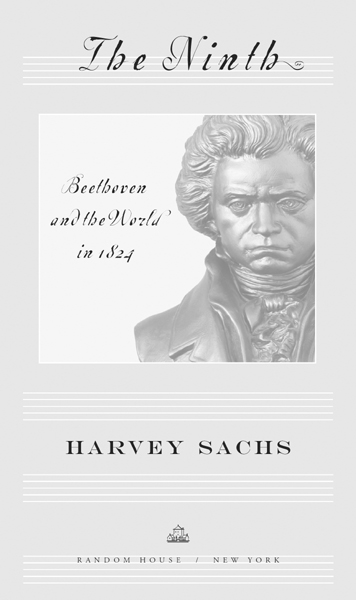ALSO BY HARVEY SACHS
Toscanini
Virtuoso
Music in Fascist Italy
Reflections on Toscanini
Rubinstein: A Life
The Letters of Arturo Toscanini
For Julian and Lyuba
Contents
PART ONE
PART TWO
PART THREE
PART FOUR
Prelude
L udwig van Beethovens Symphony No. 9 in D minor, op. 125, is one of the most precedent-shattering and influential compositions in the history of music. Its word-driven final movement is a declaration in favor of universal brotherhood, which explains why the Ninth is the work most often used to solemnize an important eventthe opening of the United Nations, the signing of a peace treaty at the end of a war, the fall of the Berlin Wall, or the consecration of a new concert hall: It is perceived as a vessel for a message that confers a quasi-religious yet nondenominational blessing on all good and just people, institutions, and enterprisesin short, on our side, whatever that may be. It has been used as a battle flag by liberals and conservatives, by democrats and autocrats, by Nazis, Communists, and anarchists. Composed during the last and most remarkable phase of Beethovens artistic trajectory, the Ninth consolidated and elaborated on elements of his earlier creations, and transcended them. It also became a reference point and stimulus for generations of artists throughout Europe and beyond, and it continues to resonate in the parallel worlds of ideas and ideals.
Charging, or cluttering, the Ninth with such ideas and ideals, not to mention feel-good meaning, was and is possible only because the last of its four movements contains words that express aspirations toward peace on earth and goodwill toward all human beings. But the first three extended, dramatic movements of the deaf composers symphonic masterpiece are not paeans of praise to freedom of the spirit or to all-embracing joy or to anything else. They deal in a variety of ways with intimate and extremely complex emotions and states of being. Thanks to its finale, however, the Ninth has become a paradigm for both freedom and joy, although it made its appearance in the middle of a decade in European history that was characterized by repression and ultraconservative nationalism, as Bourbons, Hapsburgs, Romanovs, and other terrified dynastic rulers strove to spruce up and enforce the concept of divine right in the wake of the French Revolution and the upstart Napoleons imperialism. Through this single symphonic movement, Beethoven was, in effect, serving up a one-of-a-kind counterargument to the retrograde tendencies of the day; consequently, an understanding of the circumstances under which it was created reveals as much about the politics, aesthetics, and spirit of its time as it does about its composers musical development.
Like many of the Revolutions other spiritual heirs, Beethoven had to camouflage his libertarian aspirations and pay lip service to the rulers on whose patronage he depended and for whom expressions about universal brotherhood were only too reminiscent of the ideals bandied about by the French Revolutionideals that these rulers had only recently managed to smother. And yet, Beethoven required the singers and instrumentalists who gathered in Vienna on a spring day in 1824 for the world premiere of his new symphony to proclaim, repeatedly and insistently, the potentially subversive goal of universal brotherhood. Alle Menschen werden Brder (All men become brothers) and Seid umschlungen, Millionen (Be embraced, ye millions) were the key phrases in the excerpts from an ode by Friedrich von Schiller that Beethoven set to music in the symphonys finale. The poem was called An die Freude (To Joy), but in Beethovens transforming hands it became a subtle yet robust, unmistakable ode to and prayer for suffering humanity.
From todays perspective, the premiere of Beethovens last symphony was the most significant artistic event in 1824, but other works and deeds by other artists expressed, in many different ways, discontent over the return of antiliberalism as a guiding principle and over the restoration of regimes that rejected the gains made not only by the Revolution but even by its predecessor, the Enlightenment. Byron, Pushkin, Delacroix, Stendhal, and Heine, among others, all played important parts in the years cultural history. And then there were the political figures in the real, everyday world: a fanatically religious tsar and a pope with an eye fixed on secular matters, two French kings and a South American liberator, Prince Metternich and President Monroe.
that has ever been written were lost in the expected world-wide conflagration, we must pledge ourselves to rescue this symphony, even at the peril of our lives.
Many books and essays examine in great detail Beethovens life (all or part of it), works (many or a few or only one of them), or influence (musical, cultural, or political), and I have referred to them in my notes and occasionally even in my text. But I must make a confession. I am not an authentic musicologist. I state this fact neither ashamedly nor proudly, but simply to give you an inkling of what lies ahead. My post-high-school formal education was too brief and too erratic to allow me to claim titles that others earned by doing what I was too undisciplined to do. On the other hand, by the time I made up my mind to become a fulltime writermainly about musicI was thirty-eight years old and had a dozen years experience as a conductor behind me, in addition to three published books on musical subjects. Whatever I know about music, I know from both the inside and the outside. When asked what my profession is, I usually say, for the sake of expedience, writer and music historian, but daydreamer, appreciator, and curiosity addict would be a more accurate definition. I will try to wear all five of these hats now, as I approach Beethoven and the world in which he created his Ninth Symphony. And since part of the historians task is to sift through the refuse of the past, what could be a better place to begin this tale than amid some trash bins in the city that Beethoven called home for most of his life?
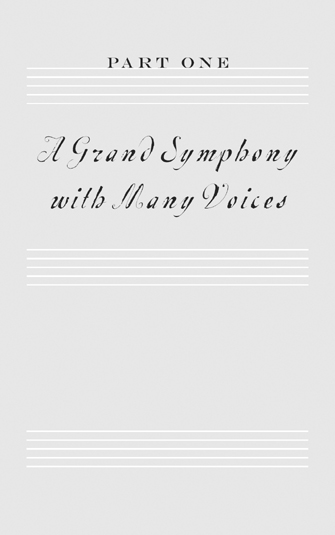
The latest news in Vienna
R eeking, rotting garbage, overflowing from bins: That is what I found when, in November 2004, I pushed open the main door of a massive but anonymous gray stone apartment building in Viennas third Bezirk (district) and made my way through a hallway to an internal courtyard. The rectangular four-story buildings faade bears a commemorative plaque put up by the Vienna Schubert Society on May 7, 1924the hundredth anniversary of the premiere of Beethovens Ninth Symphonyas well as another, more recent plaque bedecked with banners dirtied by automobile exhaust, which proclaims that the symphonys Ode to Joy theme has been the European anthem since 1972, when the Council of Ministers in Strasbourg officially adopted it as such. There is no museum in the building at Ungargasse 5, on the northwest corner of a busy intersection; in fact, by going through the entrance door I was trespassing on private property.
In the composers day the address was Landstrasse 323, and the building was called the house Zur schnen Sklavin (By the Beautiful Slave Girl); Beethoven lived in it throughout the final months of the symphonys creation and until shortly after its first performance. His apartment was situated on the top floorthe cheapest one, in pre-elevator daysbut he usually received friends and acquaintances at a nearby, no longer extant coffeehouse, Zur goldenen Birne (By the Golden Pear), where he spent many an afternoon. As one contemporary writer put it, If you have something important to tell a Viennese man, you can go ten times to his apartment without finding him in, but if you know which coffeehouse he frequents youll meet him there for sure.


